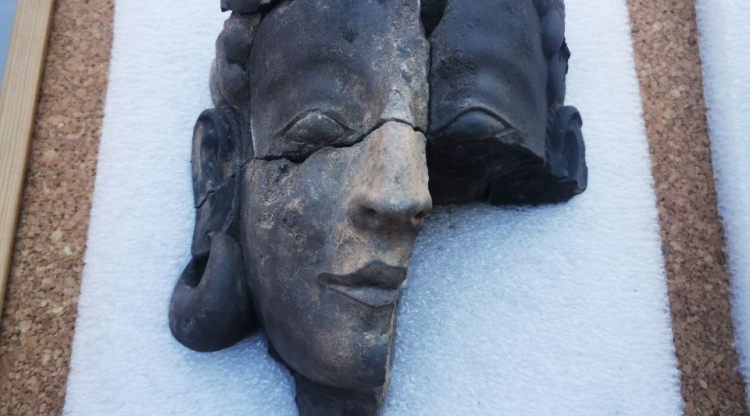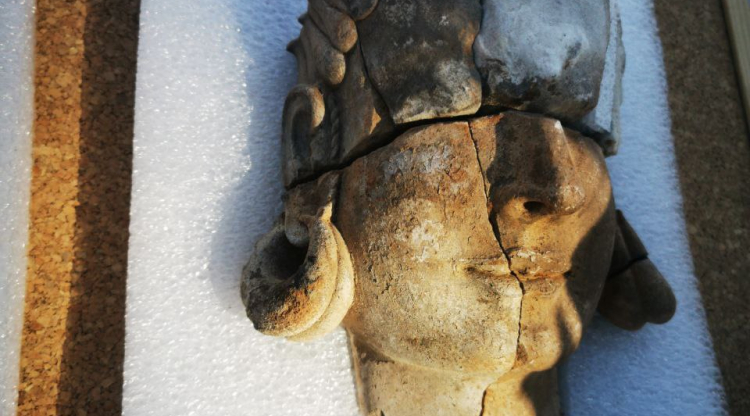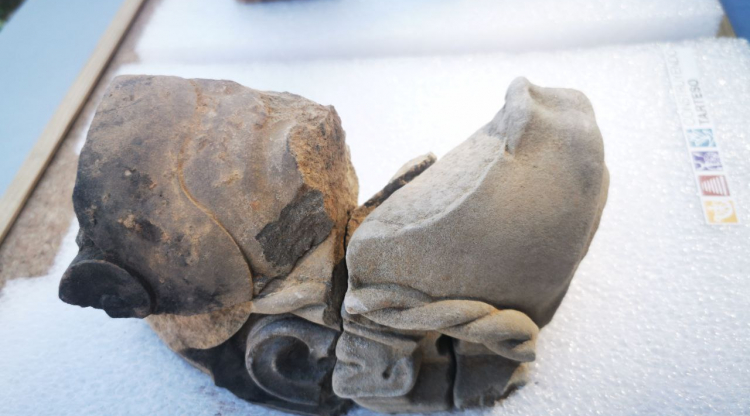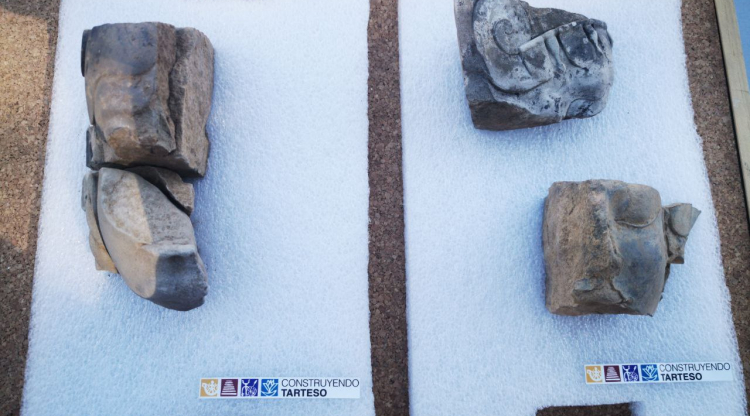CSIC researchers find the first human representations of Tartessus
The work of the Institute of Archaeology of Merida (IAM-CSIC) at the site of Casas del Turuñuelo (Badajoz) has brought to light the remains of five anthropomorphic reliefs from the 5th century BC.
The discovery was made during the excavation of the eastern sector of the site, the area leading to the courtyard of the building where a massive slaughter of animals, mainly horses, was documented. The unusual thing about the new finding is that the representations correspond to human faces.
The team of the Institute of Archaeology, a joint center of the Consejo Superior de Investigaciones Científicas (CSIC) and the Junta de Extremadura, led by Esther Rodríguez González and Sebastián Celestino Pérez, confirmed today at a press conference that, of the set recovered to date, two of the figural reliefs are almost complete and correspond to two female figures adorned with outstanding earrings or arracades that represent typical pieces of Tartessian goldsmithing.
Until now, these gold pieces were only known through the discoveries made at sites such as the Cancho Roano site or within the Aliseda treasure, a Tartessian funerary trousseau found in Cáceres. Given the technical quality and the artistic detail with which they were elaborated, it seems that we are before the representation of two female divinities of the Tartessian pantheon. However, researchers do not rule out the possibility that they are prominent figures of Tartessian society.
Along with the two female figures, other fragments of reliefs have been recovered. These belong to at least three other individuals, one of them identified as a warrior as part of the helmet is preserved.
This extraordinary finding represents a profound paradigm shift in the interpretation of Tartessus, traditionally considered an aniconic culture for representing divinity through animal or plant motifs, or through betilos (sacred stones). Finally, the finding only further emphasizes both the importance of the site and the transcendence of the Tartessian culture in the Guadiana valley during its last moments.
In addition to the research team, the press conference was attended today by the director of the IAM-CSIC, Pedro Mateos; the representative of the CSIC in Andalusia and Extremadura, Margarita Paneque; and the mayor of Guareña (Badajoz), Abel González.
Building Tarteso
Construyendo Tarteso is a project of the Agencia Estatal de Investigación within the Plan Estatal I+D+i of the Ministry of Science and Innovation. Its main objective is to characterize the Tartessian material culture through the architectural analysis of the large adobe buildings excavated in recent decades.
The Construyendo Tarteso team, which began its first excavation campaign in 2015, at the site of Casas del Turuñuelo located in Vegas Altas del Guadiana, is currently immersed in the V excavation campaign. This campaign has received the support of the General Secretary of Science, Technology, Innovation and University of the Junta de Extremadura, through the granting of a FEDER Fund, the Diputación de Badajoz and the Palarq Foundation.
In this campaign, the work is focused on the eastern sector of the site since, after the work carried out in 2022, the current objective is to try to locate the access point: the façade of the building. As they are constructions that follow an oriental pattern, they are usually oriented towards the east, that is to say, towards the sunrise. In addition, we are trying to discover if there is a symmetry with the courtyard or if there could be a door that communicates directly with the courtyard.
The site is unique in many ways, mainly because of its excellent state of preservation. To date, it is the best-preserved earthen building in the western Mediterranean. This is due, among other reasons, to the fact that it conserves its two construction levels, that is to say, the possibility of walking on both the upper and lower floors.
Its excellent state of preservation makes it possible to document construction techniques and architectural solutions that had not been documented in a Tartessian site to date. An example is the possible existence of a vault that covered one of its main rooms or the use of lime mortar, in this case, to make the ashlars of the lower steps of the staircase. Undoubtedly, this is a unique site.
In addition to the architectural elements, such as the preservation of adobe elevations up to five meters high, it is significant the massive slaughter of animals, the largest documented to date in the western Mediterranean.
On the other hand, the materials it treasures and their state of preservation are exceptional: the presence of a marble sculpture from Mount Pentelicus, of which only the feet are preserved, or the set of Macedonian glass, together with the collection of Etruscan ivories, demonstrate the cultural and material wealth of this unique enclave.
The Institute of Archaeology of Mérida
The IAM is a joint center formed by the CSIC and the Regional Government of Extremadura through the Ministry of Economy, Science and Digital Agenda. It develops its activity at regional level, in different parts of the country and beyond our borders, extending its research to numerous sites in North Africa, Europe and America. At present, the involvement of the IAM in Extremadura stands out, where it develops research projects in different parts of the Autonomous Community, as in the case of the archaeological site of Mérida or in ancient cities such as Botija, Contributa Iulia and Metellinum, among others.
One of those sites is Casas del Turuñuelo, whose research has been carried out by the institute since 2015. In addition to CSIC, researchers from more than 28 national and international research centers and universities are collaborating in this work.
Erika López / CSIC Communication Andalucía and Extremadura
comunicacion@csic.es





